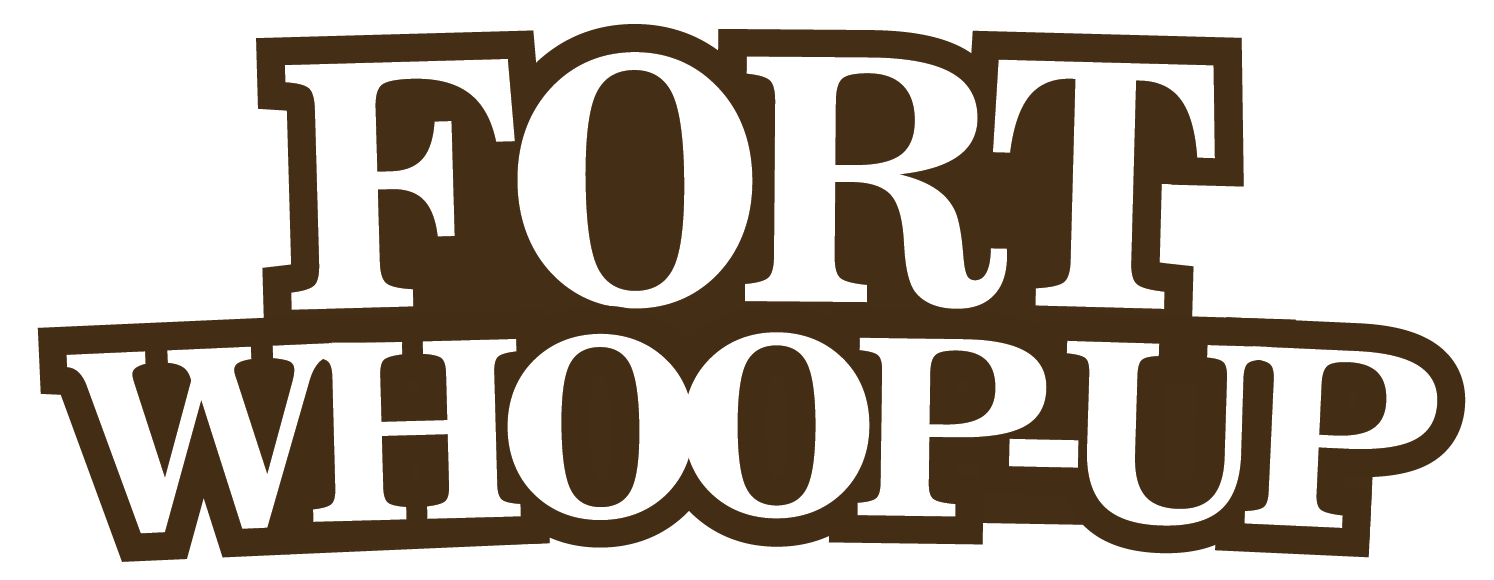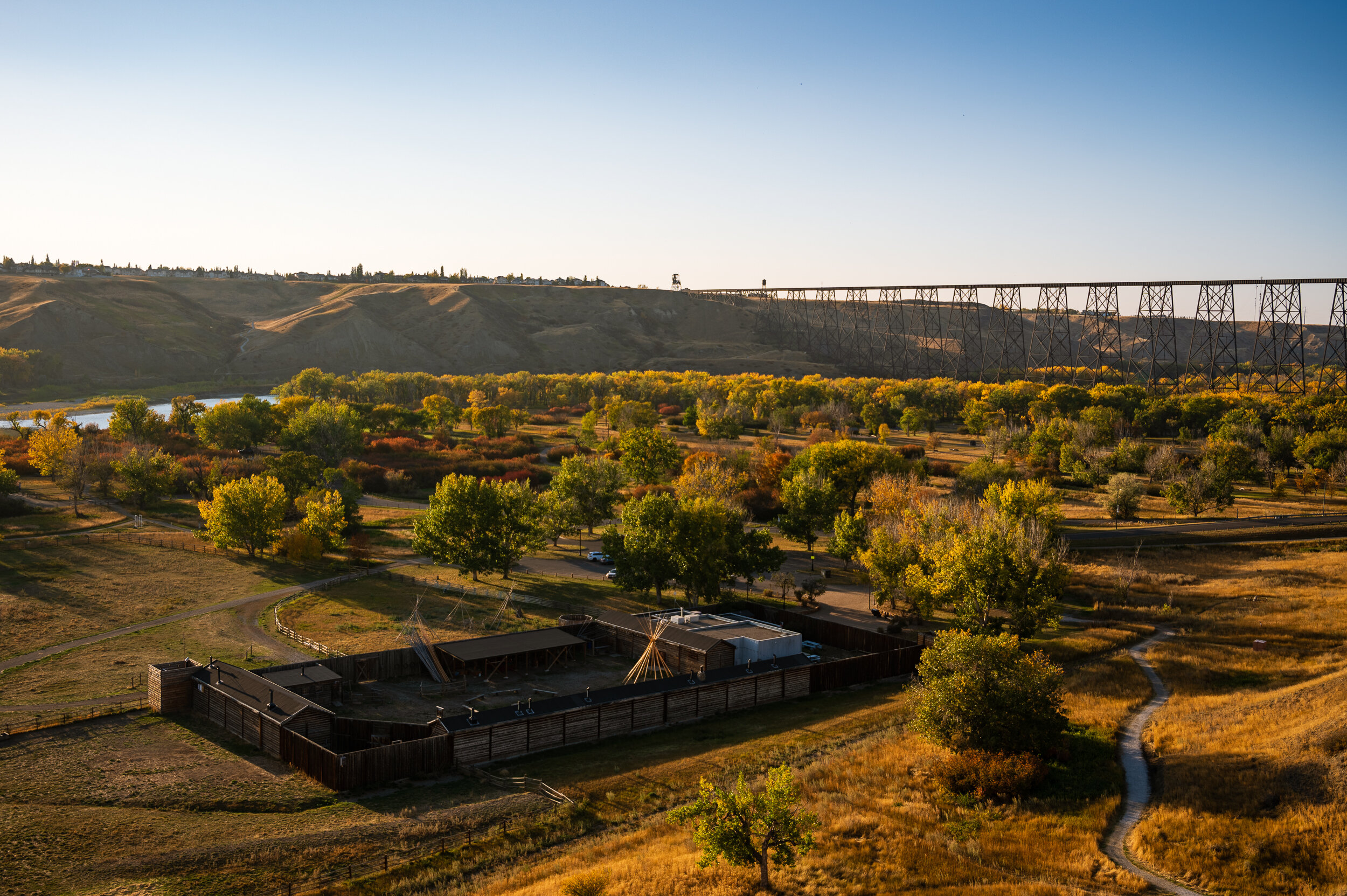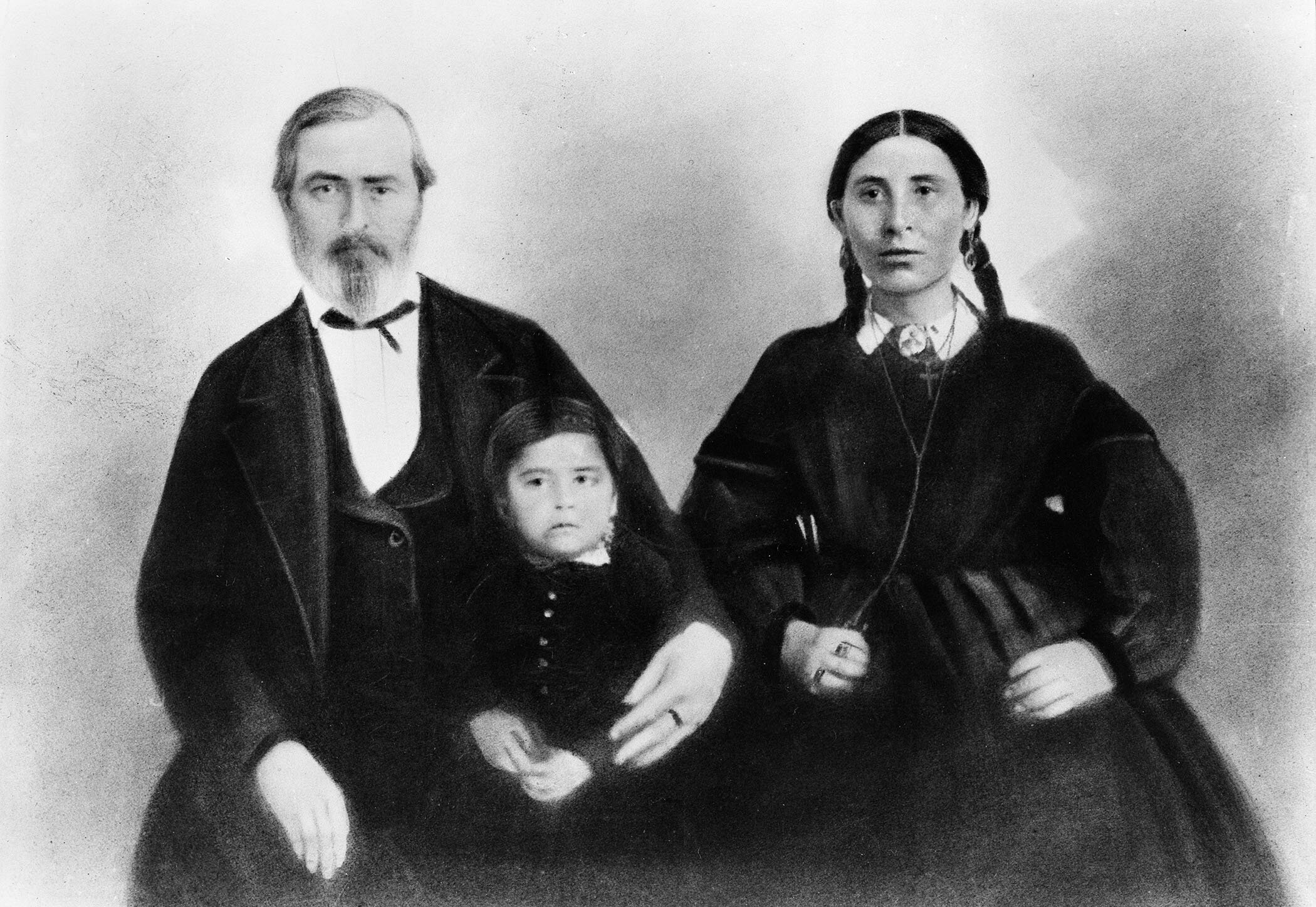What is Fort Whoop-Up?
Fort Whoop-Up is a replica of an original fur trading fort built in the late 1800s. We tell the story of the buffalo robe and illegal whisky trade, the years leading up to and the years that followed.
We tell the story of this region and the people here from the mid-1860s to the early 1890s. It is a complex story that includes the Niitsitapi (Blackfoot), other First Nations, Métis, Canadians, Americans, and British. It is a story of trade and politics, good people and notorious characters, and the flow of time.
Niitsitapi (Blackfoot)
Long before the arrival of the newcomers, Naapi gambled in the mountains. He used a special song and was able to win all the black waters flowing down from the eastern slopes. This is Kitaowahsinnoon, what sustains us... this is what we call our Blackfoot territory. It encompasses everything from the North Saskatchewan River here in Alberta, to the Yellowstone River in Wyoming, and from the Rocky Mountains far east to the Great Sand Hills in Saskatchewan. Other tribes belong to different waters, but this is our place, and it's been that way for thousands of years.
During certain seasons, especially in the summer, our way of life involved being on the move, A'pawaawahkao'p. There were places we went to hunt buffalo, and others where we got elk. There were special places abundant in berries, and lakes where we could easily harvest waterfowl eggs.
Everywhere we moved was for a purpose, and we would camp in the same areas every year. We would mark these locations with rings of stone, Momma'pis.
With the arrival and settlement of newcomers in the 1860s the traditional way of life of the Niitsitapi – the Siksika, Kainai, Piikani, and Amskapi Pikuni Nations – changed.
American Traders
After the US Civil War ended in 1865, young men flooded into Montana in search of gold and other ventures. Settlement expanded into the newly created Montana Territory.
Canada joined in Confederation in 1867, and western Canada—the “Northwest Territories” as it was then known—was transferred to the young Dominion; however, the government had no real presence in the west.
An American law made it illegal to sell or trade alcohol in Montana’s “Indian Country,” but alcohol was widely used as an incentive for trade with Indigenous people. When the Hudson’s Bay Company and the American Fur Company withdrew from trade in the late 1860s, free traders stepped in. Beyond the reach of the law, the Canadian prairies were filled with opportunity for gold prospectors, wolfers and whisky traders.
Construction
In December 1869 Alfred B. Hamilton and John J. Healy obtained supplies from Fort Benton, Montana and headed north. They set up a trading post at the meeting of the St. Mary and Belly (now Oldman) Rivers. A traditional gathering site for the bands of the Blackfoot Confederacy, the site would become the centre of a booming commercial trading post system.
Fort Hamilton was a simple structure with six rooms. Healy and Hamilton made huge profits in their first season, but their fort was badly damaged in a fire. Healy and Hamilton decided to build a larger and more permanent fort. They hired a former Hudson’s Bay Company carpenter, William Gladstone, to build the new fort with a crew of about forty, mostly Métis, men.
Fort Whoop-Up, as it became known, was built with squared cottonwood logs, and was designed for defense. It was enclosed by a palisade with a heavy oak gate, bastions, high windows and bars over the chimneys. It was also equipped with a rifle cannon on wheels and a smoothbore cannon. Buildings faced inward to an open central square. There was a kitchen, trading room, blacksmith shop, living quarters, stabling for the horses, a well and cellars.
Operations
Buffalo robes were the main trade commodity. Robes were sold in eastern markets as sleigh blankets or coats, while the hides made excellent belts for industrial machines. The robes were shipped east by steamboat on the Upper Missouri River. At the peak of the robe trade, up to 75,000 robes passed through Fort Benton, Montana each year. Most of the trade was done in winter months, when the buffalo robes were thickest. A whole “head and tail” robe was worth about $12 in trade goods, and a split robe was worth half that. First Nations’ demand for certain types and quality of goods sharpened competition among traders.
Buffalo robes, deerskins, wolf pelts, and other furs were exchanged for firearms, utensils, blankets, tobacco, flour and other provisions. The most profitable trade good was whisky, which was kept in a large barrel and dispensed by the jug or cupful. One to two liters of whisky traded for one robe. This “fire water,” as it was often called, was diluted with water, and might contain anything from chewing tobacco, to burnt sugar, tea or ink to add flavour and colour.
North-West Mounted Police
News of Healy and Hamilton’s rich profits drew other traders from Montana. The trail from Fort Benton to Fort Whoop-Up became a major route for bull trains carrying freight north and buffalo robes south. Soon there were more than fifty trading posts in what is now southern Alberta with names like Slide Out, Standoff, Kipp and Robbers’ Roost. Fort Whoop-Up was the largest and most notorious of them all. The traders were often described as crude opportunists, desperadoes and hard cases—but several went on to become respected businessmen and politicians. While few of the traders became rich, merchants such as T. C. Power and I. G. Baker built large fortunes supplying the robe trade.
Reports of devastation made their way to Ottawa. In 1873, Prime Minister Macdonald announced the formation of the North-West Mounted Police (NWMP) to bring Canadian authority to the west and to close down the whisky trade.
On hearing of the Mounted Police’s approach, some traders fled to Montana or reinvented themselves as legitimate traders. Hamilton left Fort Whoop-Up in 1873, though Healy stayed on for three more years. Near the end of their trek west, the NWMP hired a respected guide named Jerry Potts who led them to Fort Whoop-Up on October 9, 1874. But instead of a rowdy whisky trade, they found the fort nearly abandoned, with no whisky in sight.
The troops established their headquarters at Fort Macleod. From there they patrolled the region and set up additional forts and outposts. The North-West Mounted Police became respected by First Nations and feared by traders. By the end of 1875, they had brought the whisky trade under control.
A Time of Change
In July 1876, John Healy sold Fort Whoop-Up to the resident manager, Dave Akers.
Over the next five years the great buffalo herds were decimated all across the plains as a result of commercial hunting. By 1881 the robe trade was finished.
Akers turned to market gardening, and rented space in the Fort to the North-West Mounted Police. During Akers’ time there, Fort Whoop-Up was also a stopping point for stagecoach and mail service from Fort Benton. In 1893 Akers was killed by a former business partner over a long-standing argument. His death marked the end of an era.
The whisky trade had brought tremendous change to Niitsitapi social and cultural life, but it was only the beginning. Already struggling with epidemics like smallpox and tuberculosis, the Blackfoot people were devastated by the loss of the buffalo. The Tsuu T’ina, Stoney/Nakoda and Sik ksi kai tsi tapi nations signed Treaty 7 in 1877. Soon they were settled on Reserves and receiving government rations. Despite ongoing challenges, the Blackfoot people in southern Alberta were resilient and are vibrant nations with a strong traditional culture.
The landscape was also transformed in the 1890s. Railways replaced bull trains, stagecoaches and river steamboats. The trains carried settlers, who in turn established farming, irrigation and permanent towns. Since that time, the original site of Fort Whoop-Up has slowly been eroded by the changing flow of the Oldman River.
On October 28, 1963, the original site of Fort Whoop-Up at the junction of the St. Mary and Oldman Rivers was declared a National Historic Site of Canada. In 1967 a reconstruction of the fort was created in Indian Battle Park. The replica was redeveloped in the 1980s. Today, the Fort Whoop-Up facility continues to tell the complex story of the brief but formative period of the buffalo robe and whisky trade in southern Alberta.
We invite visitors here at Fort Whoop-Up to learn some of our history, language and culture. Kitohkanaiksimatsimohpinnaan... We Greet You All.


















Rebecca Many Grey Horses presents an overview of Indigenous history in southern Alberta.